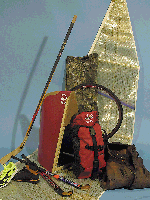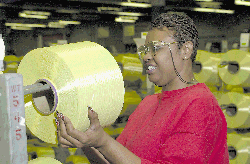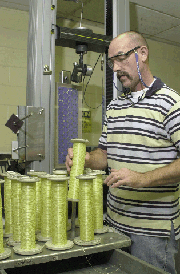The Wall of Fame is an institution at many companies. Along this few feet of space, be it in a
boardroom, lobby or other usually opulent environment, homage is paid to those people who have made
significant contributions or enrichments to the history and development of the company.At DuPonts
Spruance Plant in Richmond, Va., such a wall exists but one of a different sort. There are no
expensively commissioned portraits of company founders, no pictures of past presidents and no
tributes to corporate benefactors. There are no expensive frames, and no strategically arranged
spotlights. In fact, the display is in an area that is normally not available for public access.
Simple frames hang on a plain, painted wall that surrounds one of the plants testing laboratories.
In these frames are pictures, plaques and news clippings of men and women who owe their lives to
one of Spruances flagship products: DuPonts Kevlar®. A Household NameKevlar is an aramid fiber
originally developed in the 1960s by DuPont chemists for use in automobile tires. The advent of the
steel-belted radial limited Kevlars presence in that market segment, so DuPont scientists turned
their attention to other potential applications, in particular protective clothing. It was in this
niche that Kevlar has become virtually a household name, synonymous with bullet-proof vests, SWAT
and emergency response teams and other high-risk law-enforcement activities.Inside the test lab
around which the aforementioned photos are placed, DuPont conducts ballistics tests to determine
the capabilities of certain Kevlar weaves and constructions to absorb, contain and deflect energies
from the high-velocity impact of bullets and projectiles. Products with different weaves or fiber
construction are given grades that correspond with the force it takes to penetrate the fabric.
Depending upon the risk inherent in their assignments, law enforcement officers can choose among
Kevlar vests that stop small-caliber bullets to those that will stop .44-magnum and larger
shells.

The record of Kevlar protective garments in protecting those for whom they were designed is
impressive. Not once has a Kevlar protective garment failed to perform the task for which it was
designed, said Brian E. Foy, senior marketing specialist, Kevlar brand management. There have been
a number of instances, however, in which a Kevlar product has protected law enforcement officers
from threats for which it was not intended.Foy cited in particular a case a few years ago involving
a Virginia State Trooper. The officer made what he thought was a routine traffic stop on a Virginia
interstate. However, the cars driver shoved the officer into the traffic lanes, directly into the
path of an 18-wheel semi traveling at 65 mph. The trooper caught the impact of the truck full in
the chest and was knocked 100 feet down the highway. He was knocked unconscious and should have
died immediately from massive chest trauma. But, the Kevlar vest deflected much of the impact
force, and the lucky officer walked away with nothing more serious than severe bruises.Strangely
enough, though at least to the non-scientific mind a Kevlar vest that will stop a 9-millimeter slug
fired from 10 feet way will yield to the puncture of an ice pick thrust with only moderate arm
strength. So, for those instances in which law enforcement or military personnel are faced with a
greater danger of stabbing than shooting, DuPont manufactures a different Kevlar product that can
be woven into a puncture-resistant garment. This particular weave and multi-layer composition of
Kevlar can withstand the impact of an ice pick dropped from a height of 10 feet with four pounds of
weight, substantially more force than can be provided by a human being.With the success DuPont has
enjoyed with Kevlar in life-critical applications, its not surprising the company has now
diversified its product offering into a variety of industrial, scientific and popular consumer
market segments. As well, because of Kevlars reputation for strength, durability and abrasion
resistance, DuPont is finding some companies overemphasize the content of Kevlar within their
products, using the name to generate sales without actually providing all of the benefits of Kevlar
construction.Before exploring specific new applications for Kevlar, as well as the new licensing
program developed by DuPont, it is of benefit to look in more detail at the composition of Kevlar,
as well as its fiber forms and potential application areas. The ProductKevlar was developed in
1965 by two DuPont research scientists Stephanie Kwolek and Herbert Blades – who were looking to
create a fiber with exceptional strength, but which was also lightweight and flexible. It is an
organic fiber in the aromatic polyamide family, also known as aramid. Fibers of Kevlar consist of
long molecular chains produced from poly-paraphenylene terephthalamide. The chains are highly
oriented with strong interchain bonding that results in an unusual combination of properties.
General features include high tensile strength at low weight, high modulus (structural rigidity),
high chemical resistance, high toughness, high cut resistance, low elongation to break, low
electrical conductivity, low thermal shrinkage, excellent dimensional stability and
self-extinguishing flame resistance.

The product is available in multiple forms, including:Continuous filament yarn: This form
features high tensile strength and can be processed on conventional weaving machines, twisters,
cord-forming, stranding and serving equipment.Staple: Kevlar staple fiber features very high cut
resistance and can be spun using conventional cotton or worsted spinning equipment. Staple consists
of precision-cut short fibers, 1/4-inch or longer, and can be processed on felting and spun-lace
equipment.Wet pulp and dry floc: These consist of precision-cut short fibers, 1/4-inch or shorter
and feature thermal resistance and excellent friction and wear resistance. Pulp and floc are
miscible in blend composites.Cord: Kevlar cord features high tensile strength and modulus at low
specific weight. It retains physical properties at high and low temperature extremes, features very
low heat shrinkage and creep, and has good fatigue resistance.Fabric and prepreg: These forms of
Kevlar give good ballistic performance at low weights, excellent friction and wear performance and
excellent resistance to cuts and protrusion.

All Kevlar polymer is mixed and manufactured at Spruance. The fiber is spun at Spruance, as
well as two other DuPont locations. In addition to Kevlar, the Spruance Plant manufactures a number
of DuPonts other high-performance fiber lines, including Nomex® and Teflon®. Because of the
proprietary nature of Kevlar, DuPont prevents access to specific manufacturing processes. However,
the strength of the fiber, as well as the way it is produced, requires several innovative
processes. Kevlar polymer is mixed and stored in large hoppers. One hopper feeds the two spinning
plants at Spruance, while another stores the dry polymer for shipment to another DuPont spinning
facility. The fiber is spun and wound in a continuous process. Sulfuric acid is critical to the
formulation and production of Kevlar, so the yarn has to be washed repeatedly before it is wound.
Special finishes can be added during winding, depending upon the fabrication method anticipated for
the yarn. Because of the strength and modulus of the fiber, special cutters are required during
doffing to prevent damage. The finished yarn is wound onto packages for weaving, knitting and
nonwoven fabric formation. If necessary, additional twist can be added at this stage. Kevlar
ApplicationsA comprehensive list of Kevlar applications includes:Adhesives and sealants
Thixotropes;Ballistics and defense Anti-mine boots, cut-resistant gloves, composite helmets, and
bullet- and fragmentation-resistant vests;Belts and hoses Automotive heating/cooling systems,
industrial hoses, and automotive and industrial synchronous and power transmission belts;Composites
Aircraft structural body parts and cabin panels, boats, and sporting goods;Fiber optic and
electromechanical cables Communications and data transfer cables; ignition wires; and submarine,
aerostat and robotic tethers;Friction products and gaskets Asbestos replacement, automotive and
industrial gaskets for high-pressure/high-temperature environments; brake pads; and clutch
linings;Protective apparel Boots; chain-saw chaps; cut-resistant industrial gloves; helmets (both
for firefighters and consumer bicyclists); and thermal- and cut-protective aprons, sleeves,
etc.;Tires Aircraft, automobiles, off-road, race vehicles and trucks; andRopes and cables Antennae
guy wires, fishing line, industrial and marine utility ropes, lifting slings, mooring and emergency
tow lines, netting and webbing, and pull tapes.Kevlar brand fiber is five times stronger than steel
on an equal weight basis, Foy said, yet, at the same time, is lightweight, flexible and
comfortable. It provides reliable performance and solid strength. Because it is so lightweight,
Kevlar enhances freedom of movement even in the most extreme conditions.Kevlar draws its strength
from its long molecular structure. When a bullet hits Kevlar fabric, the fabric actually absorbs
the energy of the bullet along the molecules of each fiber, catching it in a multi-layered web of
woven fabrics. These engaged fibers absorb and disperse the energy of the impact to other fibers in
the weave.In addition to the bulletproof and puncture-resistant forms, DuPont also markets what the
company calls Multiple Threat Technology, which includes Kevlar encompassed within concealable body
soft body armor worn by special law enforcement, security, transportation and correctional
officers. It provides cut protection from commercial knives, puncture and slash resistance from
hand-made weapons and ice picks, and protection from handguns.The chemical structure of Kevlar also
gives it properties useful in industrial applications, Foy said. Gloves, sleeves and aprons benefit
from Kevlars high strength, high modulus, thermal stability and resistance to many solvents and
chemicals, he said. Kevlar offers strength under heat, protecting against thermal hazards up to
800ºF, and its flexibility enables easy movement.Protective apparel incorporating Kevlar is used in
such industries as automotive, steel, glass, metal and forestry, he said. In addition to apparel
such as protective gloves, specialized applications have been developed for specific industries.
For example, Kevlar is used in chainsaw chaps that provide cut protection for the logging industry
and U.S. Forestry Service.Other applications include protection for fiber optic cables, ropes and
high-strength composites for aviation and aerospace applications. Hot MarketsLaw enforcement
and industrial applications aside, perhaps nowhere does Kevlar have more marketing potential than
in sports, recreational and other outdoor activities, Foy said.In competitive sports, the best gear
has the tendency to bring out the best performance in the athlete, he said. The major advantage
Kevlar brings to performance-oriented activities is an adjustment in attitude. It enables the
athlete to focus on performance rather than the product. For example, a cyclist can channel all of
his or her energies into winning a race, rather than worrying about the vulnerability to flats of
tires reinforced with Kevlar.On the track, where strength and lightness is critical, running shoes
with Kevlar soles maximize the energy output of runners while protecting vulnerable parts of the
foot. For demanding outdoor recreational activities like hiking or mountain climbing, shoes that
incor-porate Kevlar technology provide support and strength and help disperse shock, increase
energy and lessen fatigue.Abrasion-resistant jackets, helmets, backpacks and other such products
are gaining wide accept-ance among motor-cylists, skaters, hikers and others. In water sports,
boats reinforced with Kevlar are lighter and more damage-tolerant, resulting in both hulls and rigs
that can withstand extreme weather conditions with improved toughness and durability, he said.
Kayaks and canoes are more resistant to damage caused by rocks and submerged tree limbs. For
sailing applications, Kevlar adds high strength and low stretch to sails, which can help increase
speed.Kevlar is a successful brand for DuPont, according to James B. Ranson Jr., global Kevlar
brand manager for Dupont Advanced Fiber Systems. Aided recall studies indicate the brand is in the
top 10 percent in brand-name overall impression among consumers and industrial market segments.
Consumers, as well, recognize the name and associate Kevlar with high performance, durability and
quality, he said. Our goal is to further increase the brand recognition of Kevlar, Ranson said.
This becomes particularly important as Kevlar becomes a major player in segments outside the
products core markets.It is the experience of DuPont that a strong brand facilitates brand and
product extension, particularly with a product such as Kevlar, Ranson said. He described Kevlar as
a transformational product. It is not what Kevlar does that is the selling point, but what it
allows other products to do. Because of the extensive name recognition of the brand, it is not
surprising that many products in high-performance arenas particularly sporting goods leverage the
Kevlar name to enhance sales, even if those same products do not necessarily use Kevlar to increase
performance.Foy and Gary M. Burnett, senior marketing communications specialist, discussed the case
of one athletic equipment manufacturer that mentioned Kevlar six times on the packaging. All well
and good, except for the fact that the product contained a very small amount of Kevlar and not in a
fashion that enhanced performance.This is an example of the Kevlar name being used to increase
sales of a product without providing the consumer any benefit, Foy said. But the fact is, Kevlar
could be used to significantly enhance the performance of this product. It is very important to us
that when the Kevlar name is on the packaging, the product delivers enhanced benefits for the
consumer. Foy said DuPont is working with the manufacturer of the athletic equipment to reformulate
the composition of the product to include Kevlar for added strength. New Licensing ProgramAs a
result of such experiences, and in a move to protect both its brand integrity and the consumer,
DuPont has initiated a new licensing program for Kevlar-enhanced products. The Kevlar Power of
Performance licensing program will benefit both serious and recreational athletes in the consumer
market and is in keeping with DuPonts corporate strategy of providing market-focused support for
its strong portfolio of technical brands, Burnett said.The new program is the result of a
three-year research program to understand and define the values, as well as both market and
consumer perceptions, associated with Kevlar. DuPont worked with a number of brand and marketing
communications experts to develop a new signature for the product, which will debut in 2001
collections.The Power of Performance program requires consumer product manufacturers to secure a
royalty-bearing license from DuPont in order to use the Kevlar brand name. This license will be
granted only after products made with Kevlar fiber have been shown to comply with stringent
quality, performance and compatibility standards, Burnett said. Royalties to DuPont, which will
depend upon the end-use of the application, will be calculated as a percentage of wholesale
price.Manufacturers that do not qualify for a license can use the Kevlar material, but they will
not be allowed to use the Kevlar name.The need to develop the Power of Performance licensing
program became apparent to DuPont when it realized the Kevlar brand and its powerful associations
to quality and performance was being used fraudulently in the marketplace, Burnett said. A recent
survey of some 40 different motorcycle gloves sold in the United Kingdom, for example, revealed an
alarmingly high number of them labeled as Kevlar or containing Kevlar when, in fact, they contained
either no Kevlar whatsoever or mere token amounts with zero protective capability.With a name and
reputation such as that of Kevlar, if the package says Kevlar, the product has to perform.
Editors Note: This is the first article in a three-part series that examines the manufacture
and marketing of synthetic fiber. ATI chose DuPonts Kevlar® for this series because of the
reputation and performance of the product, expansion of Kevlar-enhanced products into new consumer
market segments and an aggressive new licensing program undertaken by DuPont to protect the
integrity of its advanced fiber brands. In this issue, ATI provides a general overview of Kevlar.
In upcoming issues, ATI will profile a plant that weaves Kevlar and provide a look at brand-house
and retail marketing of advanced fiber products.
December 2000




